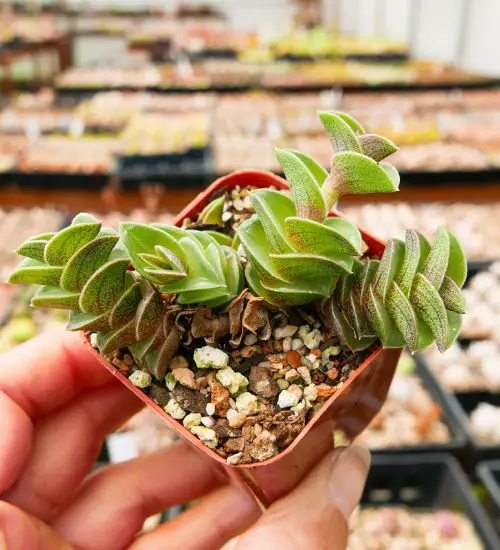Sun: Filtered sun to partial shade
Water: Typical water needs for a succulent
Temperature: Zone 10a from 30° F to 35° F (-1.1 ° C to 1.7° C) to Zone 10b from 35° F to 40° F (1.7° C to 4.4° C)
Winter Survival: Not cold hardy
Propagation: stem cuttings
Flower: in the summer
Flower Type: pink, purple
Toxic: Toxic to humans and animals
Dormant: winter
Space Requirement: Indoors & Outdoors
Common Problems: Leaf diseases, pests
Where to buy Callisia navicularis?
Basc Care for Callisia navicularis
Watering
What you need to remember is that this type of succulents needs to be watered for every 2 weeks
You can water your succulent more than often in extreme conditions but make sure that the soil is completely dry before watering your succulent again.
Fertilizing
Only feed this succulent during its active growing seasons which means winter. Use the right fertilizer applied in the right amounts. Applying half-strength balanced fertilizer every month or so is recommended for optimal results.
Do not fertilize during winter as the plant is dormant.
Sun & Location Requirements for "Chain plant, tradescantia navicularis."
When planting Callisia navicularis, keep in mind that they prefer indirect sunlight. This means that a bright spot out of the direct sun is ideal, and areas with some shade work best for them.
As per this succulent profile, it is only able to stay healthy when the environment temperature is above the range of zone 10a from 30° F to 35° F (-1.1 ° C to 1.7° C).
Callisia navicularis is not cold hardy and does not survive in freezing conditions. However, there are certain strategies that can be used to help the plant thrive despite the chill of winter. Proper drainage and insulation are essential for succulent X during periods of extreme cold. Placing a layer of mulch or gravel on the soil around the plant can also help keep it warm.
Any succulents in the group will need a medium space to grow. You can place your pot at your table or window. Since this plant needs more space than mini succulents, you should consider do not plant them together with other succulents/plants.
Callisia navicularis also benefits from some indirect light throughout the day as well, so make sure you give it enough space to soak up light without becoming too exposed to heat.
Propagation
Propagating Callisia navicularis by stem cuttings is an easy and fun way to increase your collection of these unique houseplants. When propagating, it’s important to choose healthy stems from existing plants that are at least two inches long and have several leaves attached.
Toxicity

All parts of Callisia navicularis are considered to be poisonous, and should never be ingested. Even contact with the sap can cause serious skin irritations in humans and animals, so it’s important to wear gloves when handling them.
Pests and Diseases
Callisia navicularis can be affected common pests and diseases like most of the other succulents such as aphids, mealybugs, and scale insects.
If you do spot any of pest signs, you can treat your succulent using below methods.
- Aphids: quarantine, clean infected plants, soapy water.
- Mealybugs: quarantine, clean infected plants, soapy water.
- Scale insects: quarantine, clean infected plants, soapy water.
Besides that, to prevent serious health issues from happening, keep your succulent in a well-ventilated area and check it regularly for any signs of pests or health problems.


